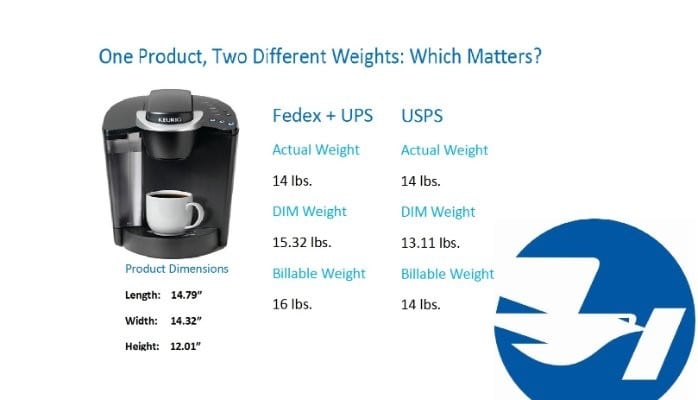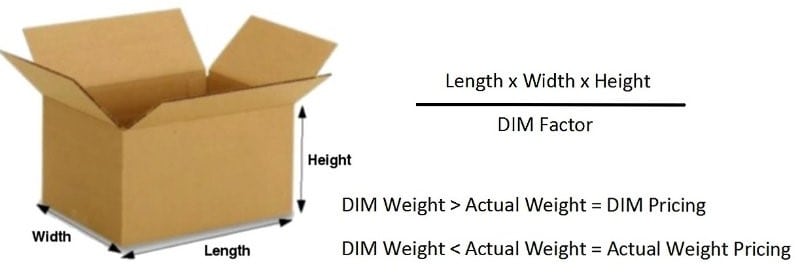
Big Shipper? Pricing May be DIM…A Guide to Dimensional Weight
Ecommerce
What is dimensional weight? Simply put, dimensional weight (DIM weight) is a pricing technique used by the transportation industry that measures the amount of space a package occupies compared to the actual weight to determine billable weight. How is DIM weight calculated? The standard formula for dimensional weight is total cubic dimensions (Length x Width x Height) divided ...
What is dimensional weight?
Simply put, dimensional weight (DIM weight) is a pricing technique used by the transportation industry that measures the amount of space a package occupies compared to the actual weight to determine billable weight.
How is DIM weight calculated?
The standard formula for dimensional weight is total cubic dimensions (Length x Width x Height) divided by dimensional weight factor (DIM Factor.) The billable weight is then determined by comparing the actual weight to the dimensional weight. Shipping cost is then calculated based upon the greater of the two weights.
*A Large Package Surcharge may apply if the length + girth=130″ The package would then be billed at 90+ lbs.
DIM Factors by Shipping Method
UPS + Fedex
- Domestic: 166
- International: 139
USPS
- Priority Mail (over 1 cubic ft:) 194
DHL
- Global: 138
Policies by Carrier
Prior to 2015, the general rule of thumb was that any domestic shipment with measurements over 5,184 cubic inches were charged dimensional pricing. Presently, the rules vary by carrier and shipping method selected.
Fedex
Dimensional weight applies to all shipments. However, when shipping internationally to Europe, the Middle East or Africa if the dimensional weight exceeds the actual weight an additional volumetric calculation must be performed to calculate the billable shipping rate.
Volumetric Calculation: Length x Width x Height (in cm) / 5000 = Billable Weight
USPS
If your package is smaller than 1 cubic foot, standard rates apply. If your package is greater than 1 cubic ft. (1,728 cubic in) then dimensional weight charges are applied.
UPS
Dimensional weight pricing applies to all shipments.
Minimizing DIM Costs
Negotiate with Your Carrier
The larger your monthly shipping output, the greater the possibility of negotiating a better contracted rate with your carrier. Companies who exclusively ship using one carrier may also be able to change their contracts by contacting their Account Manager.
In some cases, contracts may be negotiated to reflect former policies (dimensional weight pricing only on items over 3 cubic ft.) More likely, is being able to negotiate a better DIM Factor.
Example 1: One of our clients solely ships through Fedex. All of their products exceed 30 lbs. They were able to secure a DIM Factor of 194 which significantly reduced their shipping costs.
Example 2: National Fulfillment Services ships millions of packages per year. Due to our volume, we were able to negotiate better rates with our carriers. These rates vary by carrier, but typically include Commercial Plus pricing + 3-5% savings per shipment and dimensional weight charges based upon previous cubic measurements.
Save Space with Smarter Packing
Since dimensional weight pricing is largely contingent upon outer packaging, actual product measurements should be closely matched with box dimensions so that wasted space is minimized.
For businesses on a budget, free online calculators are available which utilize the product’s dimension to suggest an appropriate box size. Additional tools range from smart shipping software that pairs with scanning technology to intuitive WMS systems.
Consider Changing Carriers
In 2015 FedEx and UPS declared that all packages were subject to dimensional weight charges. Many companies chose to switch to USPS to avoid the potential price variation. However, with the United States Postal Service shipping rate increase in January, businesses may be better off switching to a regional provider or consolidator.
Regional service providers like Eastern Connection, U.S. Cargo and Skyline may be unfamiliar but according to the Wall Street Journal “they can go further faster.” Their relatively short delivery times, greater degree of accommodation, reliability in various weather conditions and 10-40% savings can make major carriers look less attractive.
Consolidators such as DHL and OSM Worldwide have seen a rise in popularity due to their economical services, door-to-door trackability, time-sensitive options and high service levels.
Regardless of your current carrier, it never hurts to look into alternative methods.
While dimensional weight may be a frustrating factor in shipping, it provides a unique opportunity to examine your distribution strategy for areas that could be optimized. Whether you decide to change packaging, switch carriers or negotiate with your current carrier your business can stand to save – in a big way.
If you still have questions about the nuances of dimensional weight, feel free to reach out to a distribution professional at National Fulfillment Services.


